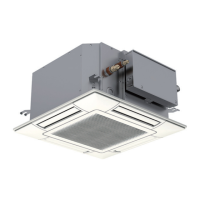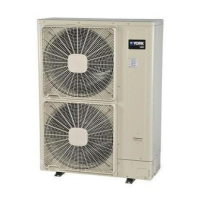P00792Q-rev.2
13
5.5 Connecting the Supply Duct
(1) The supply duct should be connected to the indoor unit through canvas ducts, in order to avoid
abnormal sound vibration (Refer to Figure 5.7). The unit is equipped with a pre-drilled duct ange for the
return and supply duct connection.
(2) Attach the vibration proof rubber to the Suspension Bolt in order to minimize sound from unit operation.
(3) Duct material should be a non-ammable material type.
(4) Perform heat insulation work over the duct to prevent condensation.
● Ifalowersoundlevelisrequired,installtheeld-suppliedsilencer.
● Designductarrangementas"UnitExternalStaticPressure=PressureDropofDuct+Pressure
DropofAirOutletandAirInlet".
Poorlydesignedductwillresultinsound,comfortandwaterblow-offissues.
<NoticeforOutdoorAirIntake(FreshAir)>
This air conditioner unit is NOT designed for outdoor use.
The following items are to be strictly observed when designing a system for fresh air intake from the
outdoors.
1) Considering Ventilation Load
Calculate the air-conditioning load properly with the load of the outdoor air intake. If the load of the outdoor
air is not considered, it may cause insufcient cooling or heating operation due to an excessive air-
conditioning load against the unit capacity.
2) Limits on Outdoor Air Intake
•
Do NOT ingest air from the outdoors directly into the indoor unit.
If an outdoor fresh air intake is necessary for air-conditioning, Johnson Controls Inc. recommends the
installation of the ERV (Energy Recovery Ventilation) (Field-supplied) system.
The outdoor air shall be processed by the ERV and mixed with indoor air.
Only then, is air that now intermixed can be drawn into the indoor unit.
NOTE:
The temperature of the air that is intermixed should fall within the working range as shown below.
Heating Cooling
Working Range of Required
Indoor Room Temperature
59 to 80
o
F DB
(15 to 27
o
C DB)
69
o
F DB/59
o
F WB (21
o
C DB/15
o
C WB)
to
89
o
F DB/73
o
F WB (32
o
C DB/23
o
C WB)
•
If the ERV is not used for processing the outdoor air, it can result in insufcient heating/cooling operation
or condensation build-up on the inside surfaces of the indoor unit or duct depending on the outdoor air
conditions.
•
The volume of fresh air is recommended to be within 20% of the airow volume “Hi2” according to the
specication’s table in the technical documentation. If it exceeds 20%, ingested condensation will build-
up on the inside surfaces of the indoor unit and the airow volume of the indoor unit cannot be adjusted
due to increasing pressure loss of air intake caused by insufcient internal static pressure.
•
When the outdoor air is ingested into the indoor unit, make sure to install an air lter capable of keeping
the indoor unit free from dust.
3) Facilities for Outdoor Air Intake
•
Use the damper or the duct fan to adjust fresh air volume.
•
Do NOT ingest in fresh air from the outdoors directly into the indoor unit.
Installing and integrating ERV as a part of the system mix is recommended if incoming air from outdoors
is routinely drawn indoors.
•
When using ERV or installing a duct fan, make sure to install the interlock circuit between them and the
indoor unit fan motor. Make sure to install an ERV in accordance with this manual.
•
Install thermal insulation on surfaces of interconnecting ducts to prevent the build-up of condensation.

